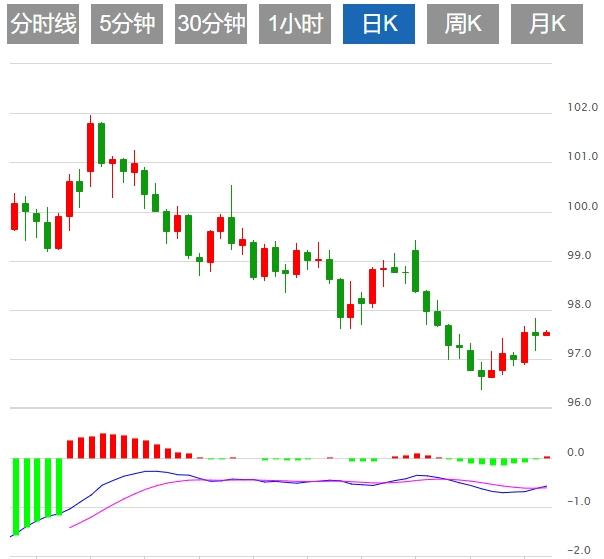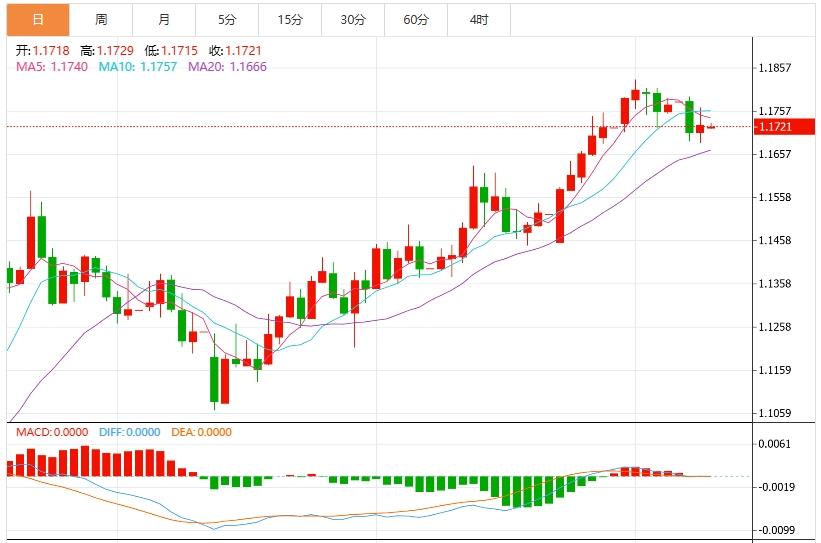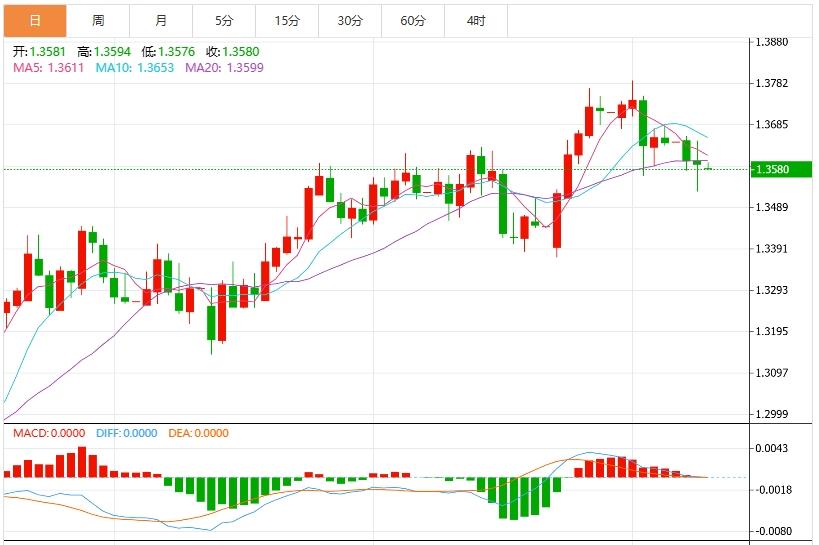Wonderful introduction:
Optimism is the line of egrets that are straight up to the blue sky, optimism is the ten thousand white sails beside the sunken boat, optimism is the lush grass that blows with the wind on the head of the parrot island, optimism is the falling red spots that turn into spring mud to protect the flowers.
Hello everyone, today Avatrade Aihua Foreign Exchange will bring you "[Aihua Foreign Exchange Market Review]: The "defense war" at the US dollar 97 mark begins! The market focus turns to the minutes of the FOMC meeting". Hope it will be helpful to you! The original content is as follows:
On the Asian session on Wednesday, the US dollar index hovered around 97.50. Looking ahead, the market trend of the US dollar index will be driven by the dual driving of tariff negotiation progress and macro data in the short term. The tariff deadline on August 1 is a key node. If the negotiations between the United States, Europe, the United States and India make a breakthrough, market risk preferences may further rebound, weakening the US dollar's risk aversion attractiveness, and DXY may fluctuate and consolidate within the range of 97.00-97.70.
Analysis of major currencies
United States dollar: As of press time, the US dollar index hovers around 97.55, and the structural pressure faced by the US dollar cannot be ignored. The continued expansion of fiscal deficits, the strengthening of interest rate cut expectations, and the potential impact of trade protectionism on global demand for the dollar may limit the upward space of the dollar. Traders need to pay close attention to the upcoming U.S. economic data (such as CPI, retail sales) and the latest statements from Fed officials, which will further clarify the direction of the US dollar. Although the current market sentiment has stabilized, the uncertainty is still high, and the short-term volatility of the US dollar may continue to amplify. From a technical perspective, the US dollar index (DXY) has shown some resilience in recent fluctuations. Last week, DXY briefly fell below the lower edge of the decline wedge pattern, touching the support level near 96.50, and then rebounded rapidly, indicating that the previous decline might be a false breakthrough. On Tuesday, DXY hit an intraday low of 97.1760 in the Asian session and rebounded to 97.5692, standing above the 9-day index moving average (EMA, 97.1073), indicating that short-term momentum has recovered. The downward wedge pattern is often seen as a potential reversal signal, with the current price returning to the inside of the wedge, suggesting that the short momentum may be weakening.



1. Trump: "Peer-to-peer tariffs" will be implemented on August 1
On July 8, local time, US President Trump posted on the social media platform "Real Social" that according to the letters sent to various countries on the 7th, and the next period of timeThe tariffs will be implemented on August 1, 2025, "this date will not change and will not change in the future." Trump announced on April 2 that he would impose so-called "reciprocal tariffs", which caused a plummeting US financial market. Under pressure from multiple parties, Trump announced on April 9 that he would suspend the imposition of high "reciprocal tariffs" on some trade targets for 90 days, but maintain a 10% "benchmark tariff." On July 7, Trump signed an executive order to extend the so-called "reciprocal tariffs" suspended period and postpone the implementation time from July 9 to August 1.
2. Trump: Powell should resign immediately
On July 8, US President Trump declared at the White House that Federal Reserve Chairman (and director) Powell should resign immediately. Powell (in terms of adjusting policy rates during my tenure) is always too late, but it is not the case during (former president) Biden's tenure. Trump seems to tell Treasury Secretary Becent that he prefers him (Best) than (more) Powell.
3. The yield on the US 20-year Treasury bond closed lower than the 30-year Treasury bond for the first time in the past four years.
The yield on the US 20-year Treasury bond closed lower than the 30-year Treasury bond yield on Monday, the first time in nearly four years, reflecting that the long-term part of the US treasury yield curve has returned to normal to some extent. Long-term Treasury yields continue to rise due to market expectations that the Fed will start to cut interest rates, while betting that the widening fiscal deficit will lead to an increase in Treasury supply. On Monday, the 30-year Treasury bond yield, which had the longest maturity, was slightly higher than the 20-year yield in late trading, the first time since October 2021. On Tuesday, the 30-year U.S. Treasury yield was still less than one basis point higher than the 20-year yield. In 2022, the Federal Reserve's interest rate hike cycle drove the yields of US Treasury bonds for all maturities, and the yield on 20-year Treasury bonds was once as much as 30 basis points higher than the 30-year period.
4. The U.S. Treasury Secretary downplayed concerns about the depreciation of the dollar, and the market speculated that the Trump administration was interested in pushing the dollar to weaken.
Soviet analyst Kit Jux pointed out in a report that the recent remarks of US Treasury Secretary Becent further strengthened the market's speculation that the Trump administration was interested in pushing the depreciation of the dollar. On Monday, Becent said in an interview with CNBC that the weakening of the dollar is not worth worrying. He called currency exchange rate fluctuations a normal phenomenon and pointed out that the decline in the US dollar was mainly affected by the appreciation of the euro. "Given the fiscal stimulus in Europe, the euro is expected," he said. Jux believes that these remarks reflect the view within the U.S. government that the depreciation of the dollar will help narrow the trade deficit. He also predicts that the euro may rise to 1.20 later this year and hit a high of 1.25 in the future.
5. Japan's largest life insurance www.avaforexcn.company expects ultra-long-term Japanese bond yields to decline
Japan's largest life insurance www.avaforexcn.company, Japan Life Insurance, told Bloomberg in a statement that as demand improves and progress in US-Japan tariff negotiations, Japan's ultra-long-term Japanese bond yields are expected to gradually increase.decline. As the U.S. demands to increase defense spending, coupled with the imminent Japanese Senate election, concerns surrounding fiscal expansion are intensifying, and the risk of rising interest rates exists, while the supply and demand gap will narrow as the Ministry of Finance reduces ultra-long-term bond issuance. The Bank of Japan has slowed down the pace of reducing the scale of Treasury bond purchases since April 2026, and the Ministry of Finance revises its ultra-long-term bond issuance plan, these are appropriate decisions made on the basis of fully considering market stability and fully listening to the opinions of market participants. The Bank of Japan may raise interest rates once in the second half of fiscal year 2025. Japan's economy is expected to slow down due to tariffs, but it will not fall into recession. If the US-Japan negotiations are in trouble and the economic impact is significant, there is a possibility that interest rate hikes may not be raised during the fiscal year.
Institutional View
1. Westpac: The New Zealand Fed is expected to remain in control in July, and the suspense of interest rate cuts is left to market interpretation. Westpac expects the New Zealand Fed to maintain its official cash interest rate unchanged at its July meeting and take a wait-and-see attitude towards the interest rate outlook. While we expect the Fed to retain its easing tendency to show in its May monetary policy statement, it is not expected to issue strong guidance on the timing of further rate cuts. Instead, we expect it to give the market room to judge for its own reasons - based on data released until before the August monetary policy statement, the market will independently decide whether the New Zealand Fed will implement a rate cut of 3% in August, whether the rate cut will be delayed until later this year, or whether the rate cut will be cancelled altogether. The Fed may point out that economic activity was stronger than expected in the first quarter of 2025, but indicators have since indicated that economic momentum has slowed, in line with its May forecast; it may also emphasize that short-term inflation is at troubling highs. 2. Capito Macro: Tariff uncertainty may postpone the Bank of Japan's interest rate hike until 2026. Capito Macro said that the tariff issue continues to lack clarity and may delay the Bank of Japan's actions to tighten monetary policy. The agency's basic forecast remains that Tokyo will reach an agreement with Washington to avoid the 25% tariff threat. If this happens quickly and does not raise tariffs, or just raise tariffs moderately, the reason for the Bank of Japan's interest rate hikes in October will not be shaken. The current inflation rate is much higher than the Bank of Japan’s forecast in May, and the Japanese economy has performed quite well so far. But economist Marcel Thieliant said any delay in further negotiations or a significant increase in tariffs could convince the central bank to delay interest rate hikes until next year. 3. Goldman Sachs expects the Federal Reserve to cut interest rates in September
3. Goldman Sachs expects the Federal Reserve to cut interest rates in September
Goldman Sachs expects the Federal Reserve to cut interest rates in September, three months ahead of the previous forecast. This shift reflects some early signs that tariff-related inflation is moderate than expected, and counter-inflationStrength—including slowing wage growth and weakening demand—is forming. David Mericle, chief economist at the bank, estimates that the probability of a rate cut in September is "slightly higher than" 50%, and is expected to cut interest rates by 25 basis points in September, October and December, and will cut interest rates twice in early 2026. Goldman Sachs also lowered its terminal interest rate expectations from 3.5%-3.75% to 3%-3.25%.
The above content is all about "[Ihua Foreign Exchange Market Review]: The "defense war" at the US dollar 97 mark begins! The market focus turns to FOMC meeting minutes". It was carefully www.avaforexcn.compiled and edited by the Avatrade Foreign Exchange editor. I hope it will be helpful to your trading! Thanks for the support!
After doing something, there will always be experience and lessons. In order to facilitate future work, we must analyze, study, summarize and concentrate the experience and lessons of previous work, and raise it to the theoretical level to understand it.















